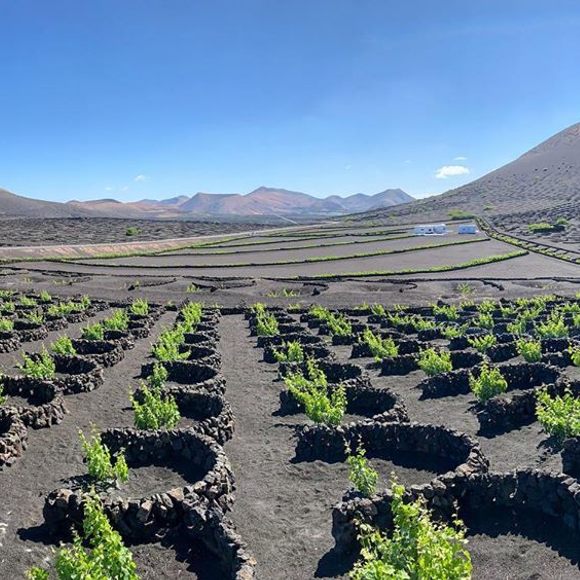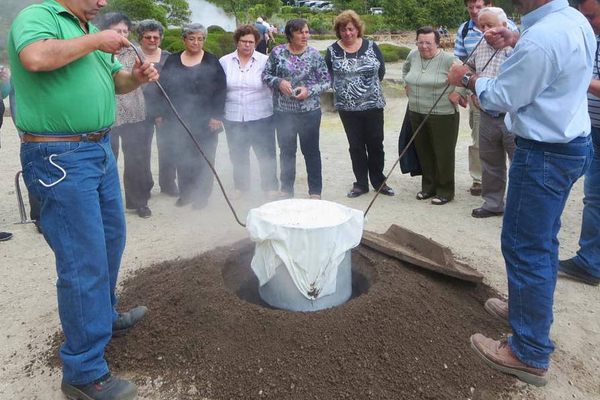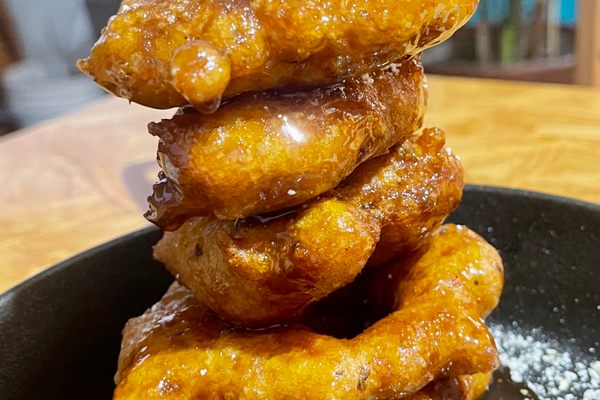Drinks
Lanzarote Wines
On an island’s moon-like terrain, grapevines creep out of ashen volcanic soil and create extraordinary elixirs.
Rising from the cinders of a terrain singed by recurring volcanic eruptions between 1730 and 1736, the vineyards of Lanzarote are a testament both to the hardiness of certain grape varietals and to the human spirit’s enduring commitment to seeking out wine in the most unlikely places. Part of the Canary Islands, Lanzarote is located off the coast of northwest Africa. Its vineyards, which border a still-active volcano, Timanfaya (part of the Timanfaya National Park), look nothing like the fertile wine-growing regions of the rest of the world.
When volcanic eruptions covered Lanzarote’s land in ash and lava, destroying most of the region’s agriculture, wine-growers became inventive. Digging crater-like hollows (called hoyos or gerias) by hand, vintners plant their vines deep into the soil, past the layers of ash. They fence off the sea-facing side with low, semi-circular walls made with lava stone. This protects the vines from winds blowing in from the Atlantic Ocean. Each vine grows on one solitary, dug-out crater, which can be as much as 30 feet wide and 15 feet deep. The array of crescent-shaped stone walls (called zocos) cocooning spots of verdant green offers a patterned visual splendor in an otherwise arid landscape.
The topsoil of ash is moisture-retentive and thermoregulatory, creating, like charmed vinous magic, perfect conditions for grapes to grow on parched terrain. The roots of the vines stay securely trapped within the nutrient-rich subsoil. Meanwhile, the high heat of the landscape allows the sugars in the grapes to develop an alluring intensity.
Lanzarote reds, whites, and rosés tend to be light and crisp. Here, among the vineyards, one can find the listán negro grape, which was brought to California by Spanish settlers but did not survive there. On Lanzarote, these grapes thrive, and make a deliciously earthy rosé. Most of the region’s wines come from Malvasia grapes, known for their sweetness. The terroir provides a distinctive mineral quality to the wines, and it should be noted that most of the grapes here are indigenous varietals, free from the grafting required of most European grapes, which might otherwise fall susceptible to the vine-destroying aphid known as phylloxera. The harvested grapes make heady wines that turn traditional viticulture on its head.
Where to Try It
-
This 17th-century estate has steadily expanded its winery. There’s a restaurant overlooking sprawling volcanic vineyards and daily wine tours.
-
The oldest winery on the island also contains a wine museum, library, and wine shop, and holds daily tours and tastings. The original wine cellar has been around since 1775.
Written By
 Rohini Chaki
Rohini Chaki
Sources
- www.mnn.com/your-home/organic-farming-gardening/stories/the-strange-volcanic-vineyards-of-lanzarote
- visitlanzarote.es/volcanoes-lanzarote/
- www.hellocanaryislands.com/nature-areas/lanzarote/protected-landscape-la-geria/
- www.foodswinesfromspain.com/spanishfoodwine/global/whats-new/features/feature-detail/lanzarote-wines.html
- www.wine-searcher.com/regions-lanzarote
- www.lanzaroteon.com/news-lanzarote/camels-in-lanzarote-how-and-why-lanzarote-on
















